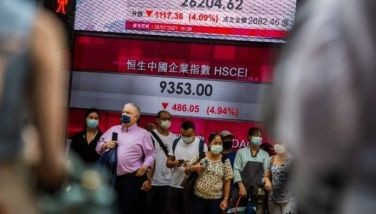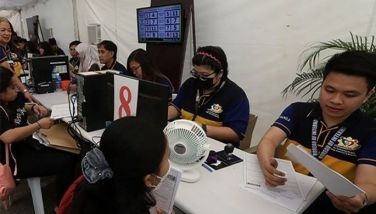The air we breathe

Never waste a good crisis. Use it to enable change for the better.
It is amusing to see so many people still using face masks a week after Taal’s eruption. Metro Manila air quality was back to normal by Monday last week. That’s the real reason why we should still use face masks.
Now that we have the people’s attention about the health problems due to dirty air, let us move on beyond volcanic ashfall to the more mundane daily dirty air we breathe. Indeed, it was determined that the air in Metro Manila was dirtier the day before the Taal Volcano eruption.
While it is true that air quality in some parts of Mega Manila was deadly at some point after the eruption, the fact remains that our air quality had long been a serious threat to our health. Without the drama of an exploding volcano, we just learned to take all that dirty air as a fact of life in our cities.
Scientists define air pollution as the presence of harmful chemicals in the air we breathe — chemicals with adverse effects on our health. All that bad air is a result of what we normally do, such as fuel combustion from vehicles, heat and power generation due to oil and coal power plants, smoke from manufacturing factories and mines, waste incineration, etc.
Flipscience.ph point out that harmful chemicals, also known as pollutants, come in various forms. The largest group is called particulate matter (PM), which includes particles that comprise sulphates, nitrates, ammonia, sodium chloride, black carbon, mineral dust. The sizes of these pollutants can be measured in microns. A micron is a millionth of a meter: picture a meter-long thread divided into a million equal parts. That’s how small a micron is.
“Particulate matter can be further classified according to their size, either as PM10 (less than 10 microns in diameter) or PM2.5 (less than 2.5 microns in diameter). These particles can remain suspended in air and eventually be inhaled. When this happens, they pass through the airway and enter the bloodstream and make us sick.
“WHO imposed air quality guidelines to provide thresholds and limits for key air pollutants that may cause health complications. Based on the guidelines, WHO estimates that reducing the amount of particulate matter (PM10) to 20 micrograms per cubic metre (µg/m3) annually would subsequently decrease air pollution-related mortality rates by 15 percent.
“For the smaller and more harmful variant, PM2.5, they imposed a standard of 10 µg/m3 per annum…
“The Philippines’ annual PM2.5 concentration rests at 18.4 µg/m3, according to the 2016 WHO report. This value is approximately 80 percent higher than the safe levels indicated by WHO.”
The leading contributor to air pollution is vehicle emission. It contributes about 69 percent to Metro Manila’s air pollution. I imagine with the worsening traffic situation, the contribution of vehicle emission to our overall air pollution level in Metro Manila has increased.
I remember once waking up to a Viber message from my friend Ed Yap warning me that “at the air monitoring public service project of Makati Rotary at Ayala Avenue corner Parkway, the realtime 24/7 reading 6:45am Wednesday - Poor! PM2.5 reading is 44.9 which is above WHO’s 25. Use your face mask!”
Other than vehicles, the growing number of high-rise buildings and infrastructure traps air pollution on the ground instead of dispersing. This makes it deathly important to require property developers to plan for more open spaces so we can all breathe better.
A May 2018 report by the World Health Organization (WHO) indicates that there were around 45.3 deaths per 100,000 individuals due to air pollution. The Philippines ranks third on the highest cases of death due to air pollution, according to the WHO.
This is why Ed made it a project of Makati Rotary to put up an air quality monitoring project when he was the club president. It was launched during the club’s 50th anniversary with the signing of a MOA between RCM and UP.
The agreement provides RCM access to the technical expertise of UP’s Institute of Environmental Science and Meteorology (IESM). The academics are ensuring the sound operation of the system, including data collation, management, interpretation and dissemination, and development of website and mobile app software.
The system is using German made GRIMM EDM365C air and meteorological monitoring units capable of automatically and continuously measuring and recording airborne particulate levels for PM10, PM2.5 and PM 10-2.5. It is equipped with meteorological sensors to measure temperature, humidity, wind speed and direction. The PM2.5 sensors conform to US EPA standards.
The project is providing air readings from three strategically located stations. Two are owned by the club in Makati and Edsa, Project 7 in QC. The third is operated by the Lung Center in QC and its readings are fed into the system under a tie up with the club.
Air quality readings with precautionary health advice may be accessed 24/7 in real time through the project website or mobile app (Airtoday.ph). Bad air quality can be life threatening to people with asthma and other respiratory diseases.
But some of the monitoring stations are now malfunctioning, probably overwhelmed by the pollution being read. Ed said they may have to send back the equipment to Germany.
The equipment still working showed what the state of our air quality since the eruption. The critical period was before midnight of Sunday when PM10 readings reached 75 or 50 percent above WHO guideline. But from midnight till Monday afternoon, both PM 10 and 2.5 ranged from good to moderate.
It is probably because there were considerably less cars on the road last Monday and the prevailing winds blew ash away from Metro Manila.
The way it stands, we may really need those N95 face masks on a daily basis specially if we are mostly on the road battling with traffic. The danger from Taal’s dust pollution is very temporary. The danger from our vehicle emissions is there to stay.
Boo Chanco’s e-mail address is [email protected]. Follow him on Twitter @boochanco
- Latest
- Trending

























